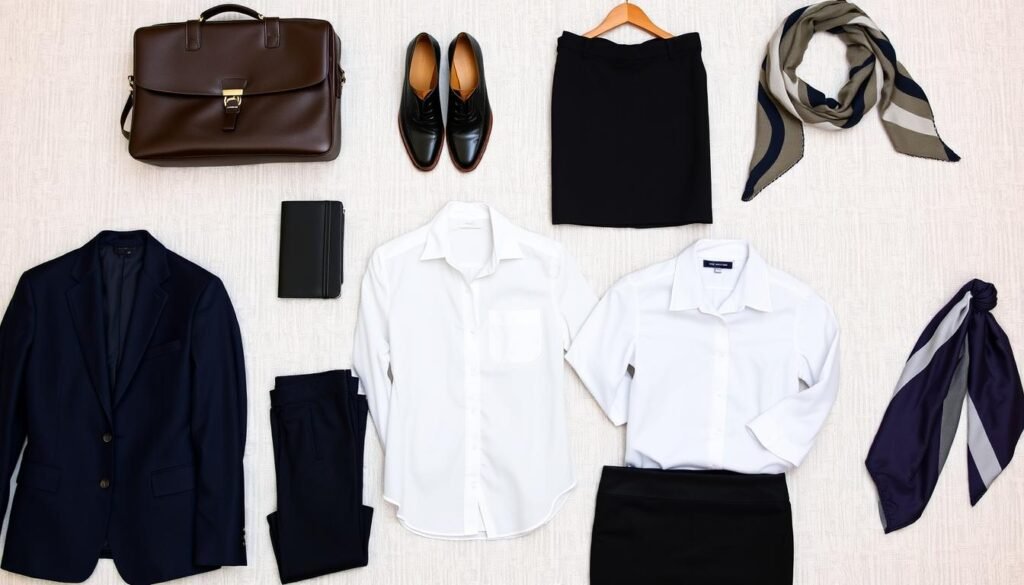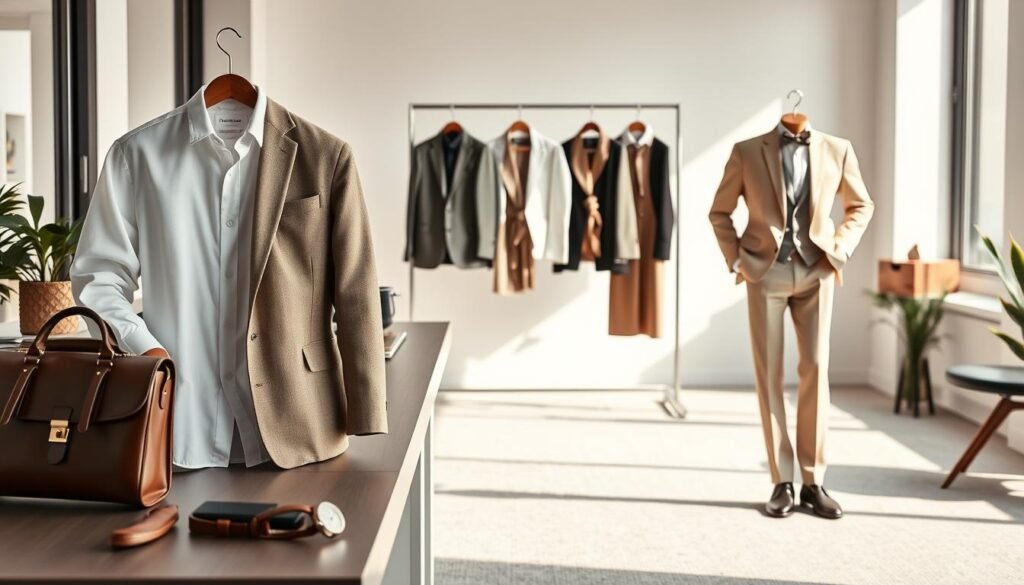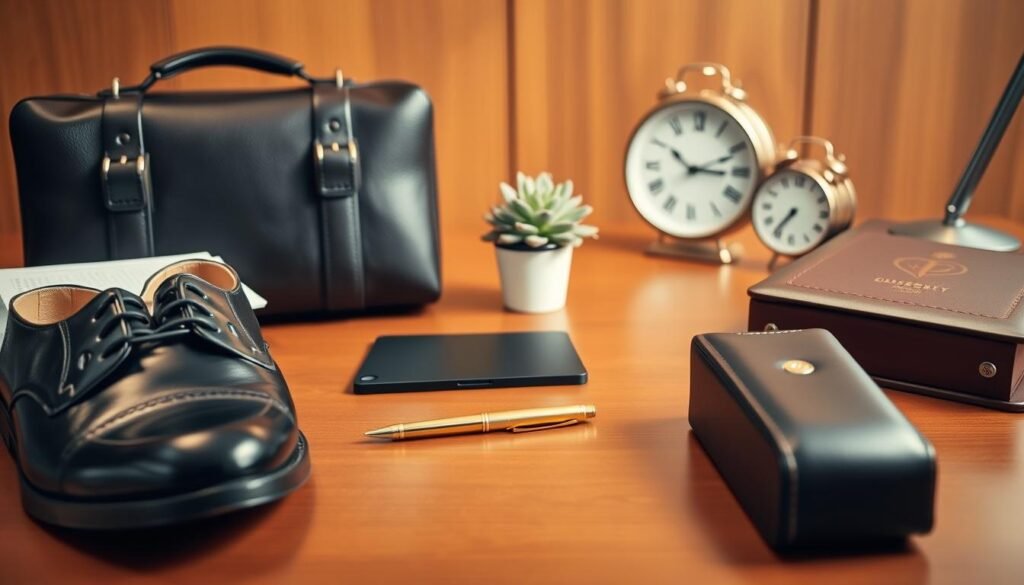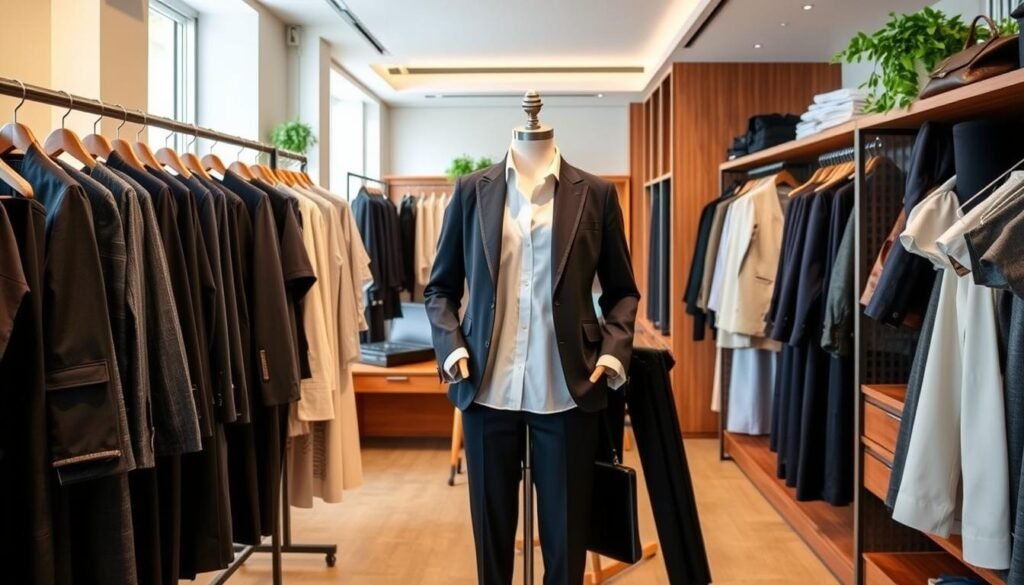“Style is a way to say who you are without having to speak,” fashion icon Rachel Zoe once said. This wisdom is very true today, with the changing workplace.
The pandemic has changed how we dress for work. Now, 79% of hybrid workers have updated their outfits. The old office dress code is gone, replaced by something more personal.
Today, professionals face many different settings. They do video calls at home, meet in person, and go to social events after work. So, your work wardrobe must be very versatile.
This guide will change how you think about workplace fashion. You’ll learn to build a wardrobe that works in many places. And you’ll also show your unique style.
Whether you’re starting your first job or updating your look, we’ve got you covered. We’ll share workwear styling tips. You’ll learn to make outfits that work from home to the office.
Key Takeaways
- Modern workplace dress codes have become more flexible due to hybrid work environments
- 79% of hybrid workers have adapted their professional clothing choices
- Versatile pieces that transition between settings are essential for today’s professionals
- Personal style can be expressed within professional boundaries
- Building a strategic wardrobe foundation saves time and money
- Video calls and in-person meetings require different styling considerations
Understanding Your Workplace Dress Code

Every workplace has its own dress code rules. Research is your best friend to figure out these rules. If you’re unsure, ask your supervisor. They can tell you what’s okay and what’s not.
Look at your company’s website and social media for clues. Also, pay attention to what your interviewers wear. This helps you understand the company culture and plan your office outfits.
Decoding Corporate Dress Codes
Workplaces usually fall into four main dress code categories:
- Business Professional: Formal attire with tailored suits and dress shoes
- Business Casual: Polished but comfortable clothing
- Smart Casual: Individual expression with dressed-down elements
- Casual: Comfortable and informal clothing
Business Casual vs Business Professional
Business professional means very formal. Think suits, conservative colors, and few accessories. Business casual is more relaxed, with dress pants, professional dresses, and optional ties for men.
The main difference is in how formal it is. Professional places want sharp lines and classic shapes. Casual places are okay with softer fabrics and looser fits.
Industry-Specific Considerations
Your industry affects business attire rules. Tech companies are usually more relaxed, while finance and law are formal.
Where you work also matters. East Coast offices are often more formal than West Coast ones. Client-facing roles usually need to be more formal, no matter the company culture.
Building Your Professional Wardrobe Foundation

Creating a professional wardrobe doesn’t have to be expensive or overwhelming. It’s all about planning and making smart choices. These choices should fit your workplace fashion needs and show your personal style. Understanding what you need and how to get it is key.
Essential Wardrobe Planning Steps
Begin by sorting through your closet. Look for pieces that could work in a professional setting with a little tweak. This helps you see what you’re missing and avoid buying too much.
Then, learn about your workplace’s dress code. Some places are casual, while others are formal. Knowing this helps you shop better and avoid mistakes.
Make a list of the must-haves you need. Choose versatile items that can be mixed and matched. This way, you can create more outfits with fewer pieces.
Budget-Friendly Wardrobe Building Strategies
Smart shoppers know that timing is everything when buying a professional wardrobe. Look for sales at the end of seasons to save on quality items. Buy winter blazers in spring and summer dresses in fall.
Check out outlet stores and consignment shops for designer items at lower prices. Many professionals donate clothes that are barely worn, giving you a chance to find great deals.
Focus on fit over brand names. A well-fitting, affordable piece looks better than an expensive one that doesn’t fit. Don’t be afraid to get things altered.
Quality vs Quantity Approach
The wardrobe building philosophy is about having fewer, better pieces. One well-fitted blazer is more valuable than three that don’t fit right.
Think about maintenance costs when choosing quality. Some professional clothes need dry cleaning, which can add up over time. Consider these costs when you buy.
| Purchase Strategy | Initial Cost | Longevity | Professional Impact |
|---|---|---|---|
| High-Quality Basics | Higher upfront | 2-5 years | Consistently polished |
| Budget Quantity | Lower upfront | 6-12 months | Variable appearance |
| Mixed Approach | Moderate upfront | 1-3 years | Balanced results |
Your professional look shows your career goals. Start with basics and add statement pieces as you can. This way, you build a wardrobe that grows with you.
Must-Have Professional Pieces for Women
Smart workwear styling begins with key pieces that open up many outfit options. Today’s work settings allow for more personal style while keeping things professional. The key to great women’s professional wear is finding versatile items that work for meetings and networking events.
The Perfect Blazer Collection
Your blazer collection is the base of your professional look. Start with a classic navy or black blazer that fits well. This one piece can turn casual clothes into something more professional.
Add blazers in neutral colors like gray, camel, or cream to your collection. These colors match well with what you already own. Look for blazers with subtle patterns or textures to add interest without losing professionalism.
Professional Dress Options
Professional dresses are both convenient and stylish. Sheath dresses are great for formal settings, while wrap dresses are comfortable and flattering. A-line and fit-and-flare styles are perfect for business casual.
Choose structured dresses for traditional offices and flowing ones for creative spaces. Midi-length dresses are a great middle ground between professional and trendy.
Versatile Blouses and Tops
Focus on classic white and light blue button-downs as your base. These timeless pieces go with any blazer, pants, or skirt. Add blouses in colors that match your wardrobe.
Look for tops with interesting details like textures, unique necklines, or small prints. These add personality without being too casual for work.
Professional Pants and Skirts
Get well-fitted trousers in navy, black, and gray for day-to-night wear. These pieces are essential for many professional outfits. Pencil skirts are classic, while A-line styles are comfortable and move well.
Think about the fabric for versatility. Wool blends are durable and structured, while ponte knits are comfy and wrinkle-free for busy days.
| Garment Type | Essential Colors | Recommended Fabrics | Styling Versatility |
|---|---|---|---|
| Blazers | Navy, Black, Gray | Wool blend, Cotton blend | High – pairs with everything |
| Professional Dresses | Navy, Black, Burgundy | Ponte knit, Crepe | Medium – standalone pieces |
| Blouses | White, Light Blue, Cream | Cotton, Silk blend | High – mix and match easily |
| Pants & Skirts | Black, Navy, Charcoal | Wool blend, Stretch fabric | High – foundation pieces |
Essential Professional Pieces for Men

Building impressive office outfits starts with knowing the must-haves for every man’s closet. Men’s professional wear has become more flexible yet keeps the polished look needed in business settings. The secret is choosing pieces that complement each other well.
Suit Essentials and Alternatives
A navy or charcoal suit that fits well is the base of professional menswear. These business suits fit any corporate setting. They can be dressed up for big meetings or toned down for daily wear.
For less formal jobs, blazers with matching trousers are great alternatives. They offer flexibility while keeping a professional look that impresses everyone.
Professional Shirt Selection
Start your shirt collection with classic white and light blue dress shirts. Choose both spread and point collar styles. Proper fit through the shoulders, chest, and sleeve length is key to looking good.
Add some variety with thin stripes or small checks. Pick different fabric weights for comfort all year while keeping that crisp, professional look.
Dress Pants and Chinos
Quality dress pants in navy, charcoal, and gray are the base for many office outfits. Chinos in neutral colors like khaki, navy, and olive are great for business casual settings.
The fit is important – pants should sit right at your natural waist with a slight break at the shoe. This makes your outfit look clean and tailored, boosting your professional image.
Ties and Accessories
Ties and accessories let you show your personality within professional limits. Start with solid colors and simple patterns. Then, try bolder designs that show who you are.
| Essential Item | Color Options | Versatility Rating | Investment Priority |
|---|---|---|---|
| Navy Suit | Navy, Charcoal | High | Essential |
| Dress Shirts | White, Light Blue | High | Essential |
| Dress Pants | Navy, Charcoal, Gray | Medium | Important |
| Leather Belt | Black, Brown | High | Essential |
A quality leather belt that matches your shoes, a classic watch, and subtle cufflinks complete your look. Modern professional dressing lets you be more creative than old rules.
Mastering Workwear Styling Techniques

Learning workwear styling techniques can make your work clothes stand out. These methods help you create looks that show your personality and fit in at work. By styling your clothes well, you can feel more confident and stylish.
Color Coordination and Pattern Mixing
Start with neutral colors like navy, gray, black, or beige. Then, add one or two accent shades. The 60-30-10 rule is great for workplace fashion: 60% neutral, 30% secondary, and 10% accent through accessories.
When mixing patterns, balance is key. Mix different scales, like thin stripes with large plaids, but keep colors similar. Let one pattern be bold and the others subtle for harmony.
Layering for Professional Looks
Layering adds interest and flexibility for changing environments. Learn to layer blazers over sweaters, cardigans over blouses, or jackets over dresses. Each layer should be stylish and practical.
Think about the temperature when planning layers. Pieces like cardigans and blazers can easily switch from air-conditioned to outdoor settings.
Accessorizing Your Work Outfits
Accessories can show your personality while staying professional. A bold watch, elegant scarf, or interesting belt can make simple outfits pop. Jewelry should be understated but meaningful, complementing your outfit.
Professional styling benefits from smart accessory choices. Pick pieces that work with many outfits to get the most value and create a cohesive look.
Creating Outfit Formulas
Make reliable outfit formulas to simplify your mornings. Create go-to combinations in different colors and textures. Take photos of successful looks for quick reference.
| Occasion | Formula | Key Pieces | Styling Tips |
|---|---|---|---|
| Client Meetings | Blazer + Blouse + Trousers | Tailored blazer, crisp shirt, dress pants | Add statement jewelry for polish |
| Casual Fridays | Sweater + Chinos + Loafers | Quality knitwear, pressed chinos, leather shoes | Layer with blazer if needed |
| Video Calls | Professional Top + Comfortable Bottom | Structured blouse, comfortable pants | Focus on upper body styling |
| Networking Events | Dress + Blazer + Heels | Professional dress, fitted jacket, pumps | Choose memorable but appropriate colors |
This method ensures you always look polished while showing your style. Regular practice boosts your confidence and makes mornings easier.
Professional Footwear and Accessories

Professional shoes and accessories add a polished touch to your look. They also meet daily work needs. These details show you care and catch your employer’s eye.
Choosing the Right Work Shoes
Classic leather options are top choices for offices. Pick black or brown shoes that match your suit. Men can go for Oxfords or loafers, while women might prefer pumps or flats.
Today’s workplaces also value comfort. Leather sneakers, block heels, and cushioned flats are stylish yet comfy. Think about your daily tasks when picking shoes.
For busy folks, the commuter shoe trick is smart. Wear comfy shoes to travel, then switch to dressier ones at work. It’s good for your feet and your shoes.
Professional Bags and Briefcases
Your bag should hold your essentials and match your style. Structured totes, classic briefcases, and sleek laptop bags show you’re organized and professional.
Stick to neutral colors like black, brown, or navy. They go with many outfits. Make sure the size is right, not too big or too small.
Watches and Jewelry Guidelines
A watch shows you’re on time and detail-oriented. A classic watch in gold, silver, or leather fits most workplaces.
When it comes to jewelry, keep it simple and elegant:
- Simple stud earrings or small hoops
- Classic pendant necklaces
- Professional bracelets or watches
- Minimal rings
Stay away from trendy or noisy jewelry. Your accessories should support your image, not overshadow it.
Seasonal Workwear Adaptations
Professional dressing needs careful planning for each season. Your clothes should match the weather and meet your workplace’s standards. Smart seasonal workwear choices ensure you stay comfortable and confident all year.
Warm Weather Professional Looks
Spring and summer are great for updating your office style with lighter fabrics and colors. Breathable materials like cotton, linen, and wool blends are perfect for warm weather.
Sleeveless blouses and dresses paired with blazers are great for meetings. Light colors like pastels and whites keep you cool while looking professional. But, choose fabrics that don’t cling too much.
Cold Weather Office Styling
Fall and winter call for richer colors and heavier fabrics for warmth and style. Wool blazers, cashmere sweaters, and structured coats are key for colder months.
Layering is key for staying stylish in the office. Start with base layers and add more as needed. Deep jewel tones, classic plaids, and tweeds add interest in the darker months.
“The key to professional dressing is adapting to your environment while maintaining your personal style and workplace standards.”
Weather Transition Solutions
Unpredictable weather demands versatile workwear. Keep a blazer or cardigan at your desk for cooler spaces. Choose pieces that layer well for changing temperatures.
Lightweight scarves, wraps, and cardigans are great for adjusting to the day’s temperature. Fabrics like ponte knits and wool blends offer structure and comfort in any weather.
Grooming and Personal Care Essentials
Grooming and personal care are key to making your workwear styling stand out. Even the best outfits can look off without these details. Watching how colleagues dress and taking notes helps set grooming standards for your workplace. It’s important to talk about personal, cultural, or religious needs with your boss to fit in.
Professional Hairstyles and Maintenance
Your hairstyle should be neat and fit your job. Styles like bobs, low ponytails, and short haircuts are usually safe choices. Getting regular trims keeps your hair looking good and healthy.
Using good styling products helps keep your hair looking great all day. If you have long hair, make sure it doesn’t get in the way of your work or meetings.
Appropriate Makeup for the Workplace
Workplace makeup should enhance your natural look, not change it too much. A good look includes clean skin, neutral eyeshadows, and defined brows. You want to look well-rested and put-together, not too made up.
Think about your job when choosing makeup. Creative jobs might let you be more expressive, while corporate jobs prefer a more conservative look.
Personal Hygiene Standards
Good hygiene is more than just being clean. It’s about paying attention to details that show how professional you are. This includes taking care of your teeth, keeping your nails neat, and using the right perfume. These things help you feel confident and well-presented.
Common Workwear Mistakes to Avoid
Even the most expensive clothes can fail if you make common workwear errors. These mistakes can hurt your credibility and professional image, no matter your budget.
Knowing and avoiding these mistakes will help you keep a professional look. This supports your career goals.
Fit and Sizing Issues
Poor fit is the biggest professional styling mistake. Pants that puddle, blazers that pull, or shirts that gap make you look unprofessional.
Even cheap clothes look good if they fit right. But expensive clothes look bad if they don’t. Invest in basic tailoring for your key pieces – it’s worth it.
Inappropriate Style Choices
Many office outfits fail because they’re too casual or trendy. Clothes that are too tight, revealing, or not fitting the workplace can harm your reputation.
When in doubt, dress a bit too formally. Watch what successful colleagues wear and follow their lead.
Maintenance and Care Neglect
Washing a suit in the machine can ruin it. Professional clothes need special care, like dry cleaning every four to five times.
Make a routine for caring for your clothes. Clean them regularly, store them properly, and fix them quickly. Well-kept, moderate-quality clothes often look better than expensive, neglected ones. This helps you avoid workwear errors.
Building Your Professional Style Legacy
Creating a strong professional look is more than following trends. This guide has shown you how to build a wardrobe that supports your career goals. It also lets you express your personal style.
Your journey to professional success begins with understanding your workplace culture. Invest in quality pieces that fit well. The basics, like a well-fitted blazer, quality dress shirts, and comfortable shoes, are key.
Fashion changes, and so should your professional style. What worked five years ago might need updating. Stay current with industry changes while keeping your core pieces fresh and well-maintained.
Building a professional wardrobe takes time. Start with essential pieces and add more gradually. Choose versatile items that can be mixed and matched. This saves money and gives you more outfit options.
The modern workplace values authenticity alongside professionalism. Use this guide as your roadmap, but make it your own. Your professional look should tell your story and open doors to new opportunities. Dress for where you want to be, not just where you are today.

